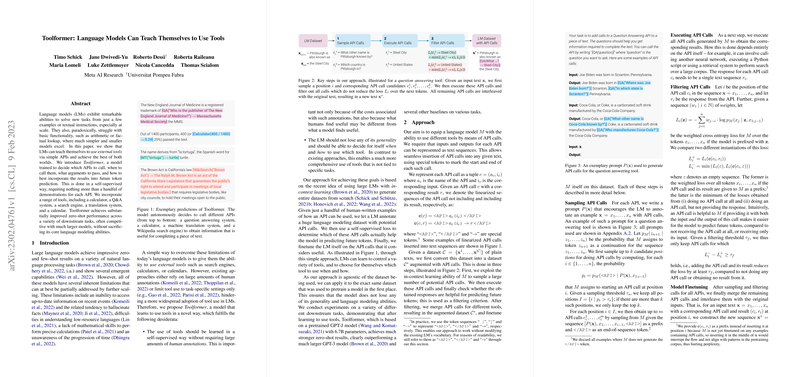Toolformer: Teaching LLMs to Autonomously Utilize APIs
Overview
LLMs (LMs) have shown remarkable proficiency in numerous natural language processing tasks by leveraging large datasets for pretraining. Despite their success, these models encounter limitations when tasked with problems that require real-time data access, arithmetic precision, or understanding of low-resource languages. The paper introduces Toolformer, a novel approach that enables LMs to autonomously decide when and how to utilize external tools via simple APIs. This capability is acquired through a self-supervised learning process that does not necessitate extensive human annotation, thus preserving the model's generality across tasks. By incorporating tools such as calculators, translation systems, and search engines, Toolformer demonstrates substantial enhancements in zero-shot performance on diverse downstream tasks without compromising its intrinsic LLMing capabilities.
Methodology
Toolformer is predicated on the insight that LMs can generate and evaluate their own dataset annotations using APIs, provided they have a handful of demonstrations for each tool. The LM is fine-tuned on an augmented dataset where API calls and their outcomes are integrated based on a self-supervised loss calculation, which measures the utility of these insertions in predicting subsequent tokens. This process involves several steps:
- API Call Sampling: Utilizing in-context learning capabilities to sample potential API calls within textual inputs.
- Execution and Filtering of API Calls: Executing sampled API calls, followed by a filtering step that retains only those calls that aid in reducing the prediction loss for subsequent tokens.
- Finetuning the LM: Using the augmented dataset to fine-tune the LM, thus enabling it to learn the utility of making API calls across a range of contexts.
This methodology facilitates a LM's ability to autonomously leverage external tools that compensate for its innate limitations.
Experiments and Results
The experimental evaluation of Toolformer illustrates its effectiveness across a spectrum of tasks:
- Factual Completion: Toolformer shows an impressive ability to improve performance on tasks that require factual completion, such as the LAMA benchmark, by leveraging a question-answering system.
- Mathematical Reasoning: Performance on mathematical datasets significantly benefit from the model's capability to utilize a calculator API, with results that surpass those of much larger models.
- Multilingual and Temporal Understanding: Through the use of translation and calendar tools, Toolformer demonstrates improved performance on multilingual question answering and tasks that require temporal awareness.
Toolformer's ability to autonomously decide the most appropriate tool to use, and its application thereof, leads to performance improvements that were previously unattainable without human intervention or explicit instruction on tool usage.
Implications and Future Work
The introduction of Toolformer opens several avenues for future research and practical application in the field of generative AI. Its ability to augment LMs with the capability to interface with external tools autonomously and in a context-aware manner can significantly expand the scope of tasks these models can handle effectively. This includes real-time information retrieval, precise quantitative analysis, and handling inputs in low-resource languages with greater accuracy.
Potential future developments could focus on enhancing the interactive capabilities of Toolformer, enabling it to perform sequential tool usage and iteratively refine queries based on tool responses. Such advancements could further bridge the gap between the static knowledge embedded in pretraining datasets and the dynamic information landscape of the real world.
By extending the functional reach of LMs through self-taught tool use, Toolformer presents a compelling narrative on the evolving capabilities of generative AI, marking an important step towards more versatile and autonomous artificial intelligence systems.
